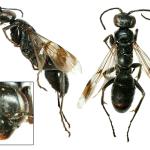An all-black species with bifasciate wings. Identification is not too difficult using Day (1988), but it should be noted that the captions to figures 40 and 42 are transposed. The generic name refers to the tufts of forward-pointing bristles on the maxilla of the female; these are used to pack the nest entrance with old spider silk.
Concentrated on Hampshire, Surrey and Sussex, with a few other records from further north. A record from North Wiltshire in Falk, (1991) is based on a misidentification.
Overseas, the species is found in northern and central Europe, and eastwards to central Asia (Wolf 1972).
Shirt (1987) and Falk (1991) list this species as Rare (RDB3). Current data supports this view.
Most recent records come from wooded downland. An old record from Portland, Dorset (Spooner, 1942) presumably comes from a treeless, rocky area.
June to September. The species (as Deuteragenia intermedia) is said by Haupt (1927) to overwinter as an adult female, but the synonymy must be questioned as his descriptions of some species of the genus disagree with British examples (e.g. Perkins 1930, in which bifasciatus is considered a separate species not recorded from this country). The phenology of British captures does little to support the suggestion of hibernation in the adult stage.
The prey consist of spiders of the family Thomisidae (crab spiders); Xysticus cristatus is mentioned by Currie (1950).
Nests are usually made in old insect burrows in dead wood, but cavities in walls and rocks may also be used. Several cells are made, separated from each other by chewed wood held together with spider silk. The nest entrance is also closed with chewed wood.
No information available. Most records are of adults running about on tree trunks; also from Malaise and flight interception traps.
No information available.


